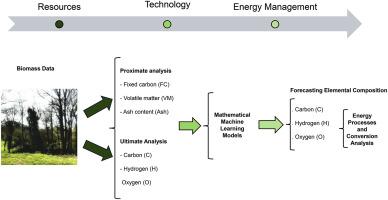Interpretable machine learning models for forecasting elemental composition of solid biomass fuels from proximate analyses in energy processes
IF 6.2
2区 工程技术
Q2 ENERGY & FUELS
引用次数: 0
Abstract
Biomass is a renewable and sustainable source of green energy. A key factor in evaluating its energy potential is its elemental composition—primarily carbon (C), hydrogen (H), and oxygen (O). This information is vital for accurate material balance calculations, efficient design and operation of combustion systems, and determining oxidant requirements for combustion and gasification. It also enables prediction of gas composition from these processes. While ultimate analysis provides this elemental data (i.e., carbon (C), hydrogen (H), oxygen (O), nitrogen (N), and sulphur (S)), it is expensive and time-consuming. In contrast, proximate analysis is simpler, offering data on moisture content (MC), volatile matter (VM), ash content (Ash), and fixed carbon (FC). Predicting elemental composition from proximate analysis requires robust models. This study develops nonlinear predictive models using two machine learning (ML) techniques: multilayer perceptron (MLP) and a hybrid approach combining the Harmonic Search Optimization Algorithm (HSOA) with Multivariate Adaptive Regression Splines (MARS). Based on a dataset of 203 biomass samples, six ML models were built to estimate C, H, and O content. Results show these ML models outperform traditional linear models in accuracy and generalizability. Specifically, the optimal HS/MARS models achieved coefficients of determination of 0.8339, 0.8676, and 0.8714 for C, H, and O, respectively. The HS/MARS models also outperformed the MLP models, demonstrating their superior predictive capability.

从能源过程的近似分析中预测固体生物质燃料元素组成的可解释机器学习模型
生物质是一种可再生和可持续的绿色能源。评估其能量潜力的一个关键因素是其元素组成——主要是碳(C)、氢(H)和氧(O)。这些信息对于精确的物质平衡计算、燃烧系统的有效设计和操作以及确定燃烧和气化的氧化剂要求至关重要。它还可以预测这些过程中的气体成分。虽然最终分析提供了这些元素数据(即碳(C)、氢(H)、氧(O)、氮(N)和硫(S)),但它既昂贵又耗时。相比之下,近似分析更简单,提供有关水分含量(MC),挥发物(VM),灰分含量(ash)和固定碳(FC)的数据。从近似分析预测元素组成需要稳健的模型。本研究使用两种机器学习(ML)技术开发非线性预测模型:多层感知器(MLP)和将谐波搜索优化算法(HSOA)与多元自适应回归样条(MARS)相结合的混合方法。基于203个生物质样品的数据集,建立了6个ML模型来估计C、H和O的含量。结果表明,这些机器学习模型在准确性和泛化性方面优于传统的线性模型。其中,HS/MARS模型对碳、氢和氧的决定系数分别为0.8339、0.8676和0.8714。HS/MARS模型也优于MLP模型,证明了其优越的预测能力。
本文章由计算机程序翻译,如有差异,请以英文原文为准。
求助全文
约1分钟内获得全文
求助全文
来源期刊

Journal of The Energy Institute
工程技术-能源与燃料
CiteScore
10.60
自引率
5.30%
发文量
166
审稿时长
16 days
期刊介绍:
The Journal of the Energy Institute provides peer reviewed coverage of original high quality research on energy, engineering and technology.The coverage is broad and the main areas of interest include:
Combustion engineering and associated technologies; process heating; power generation; engines and propulsion; emissions and environmental pollution control; clean coal technologies; carbon abatement technologies
Emissions and environmental pollution control; safety and hazards;
Clean coal technologies; carbon abatement technologies, including carbon capture and storage, CCS;
Petroleum engineering and fuel quality, including storage and transport
Alternative energy sources; biomass utilisation and biomass conversion technologies; energy from waste, incineration and recycling
Energy conversion, energy recovery and energy efficiency; space heating, fuel cells, heat pumps and cooling systems
Energy storage
The journal''s coverage reflects changes in energy technology that result from the transition to more efficient energy production and end use together with reduced carbon emission.
 求助内容:
求助内容: 应助结果提醒方式:
应助结果提醒方式:


